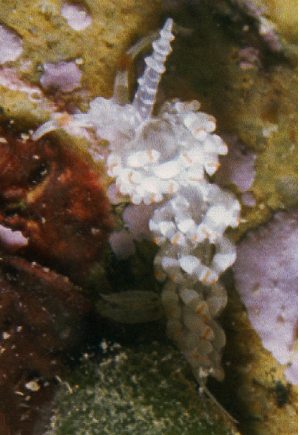
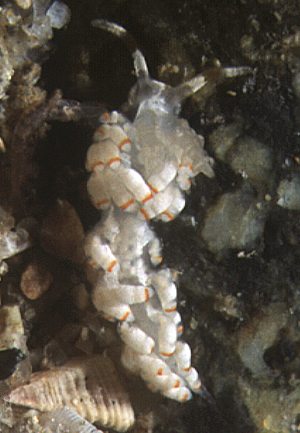
Cuthona pinnifera
(Baba, 1949)
Order: NUDIBRANCHIA
Suborder: AEOLIDINA
Family: Tergipedidae
DISTRIBUTION
Japan, Hawaiian Ids.
PHOTO
Uozu, Toyama Bay. 12mm long alive. 20 April 2002. Photo courtesy of the Takaoka Biological Club, Japan.
The rhinophores are relatively long with a number of irregular semi-circular plates arranged along their length. The body is translucent white with opaque white mottling. The oral tentacles are translucent clear with two broad white bands, one in the upper quarter the other in the second quarter from the base. Between these white bands the translucent region is pigmented with yellow-orange, which is clealry visible in some lights and apprently absent in others. The cerata are also white or translucent with broad white bands, and there is a yellow-orange band near the tip. This semicircular plates on the rhinophores and the yellow band on the cerata seem to be characteristc of this species.
See Cuthona cf. pinnnata.
References:
• Abe, T. (1964) Opisthobranchia of Toyama Bay and adjacent waters. Hokuryu-kan, Tokyo. 99pp., 36 Plates.
• Baba, K (1949) Opisthobranchia of Sagami Bay collected by His Majesty The Emperor of Japan. Iwanami Shoyen, Tokyo. 194pp., 50 Pls.
• Gosliner, T.M. (1979) The systematics of the Aeolidiacea (Nudibranchia: Mollusca) of the Hawaiian Islands, with descriptions of two new species. Pacific Science, 33(1): 37-77.
Rudman, W.B., 2002 (July 14) Cuthona pinnifera (Baba, 1949). [In] Sea Slug Forum. Australian Museum, Sydney. Available from http://www.seaslugforum.net/find/cuthpinn
Related messages
Cuthona pinnifera from Midway Is
July 16, 2002
From: Terry Gosliner
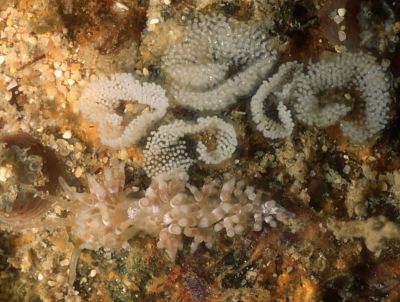
Dear Bill,
I am sending several images of Cuthona pinnifera from Midway Island in the Hawaiian Islands. I think the animals that you posted before are something different. They appear to have angular foot corners. Certainly the color is different, as well.
• Gosliner, T.M. (1979) The systematics of the Aeolidiacea (Nudibranchia: Mollusca) of the Hawaiian Islands, with descriptions of two new species. Pacific Science, 33(1): 37-77.
Terry
tgosline@calacademy.org
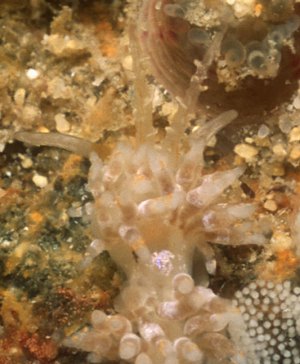
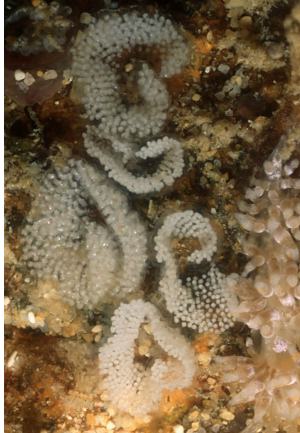
Thanks Terry,
I agree that Cuthona cf. pinnifera is not C. pinnifera. Shigeru's message with 'typical' animals from Japan, and your animals from Midway remove any doubts I might have had. I agree that the anterior foot corners of Cuthona cf. pinnifera are probably tentacular which would suggest it may be a glaucid of some sort. These semicircular plates on the rhinophores, while peculiar, are not unique to C. pinnifera.
Best wishes,
Bill Rudman
Cuthona pinnifera from The Japan Sea
July 16, 2002
From: Shigeru Hayashi
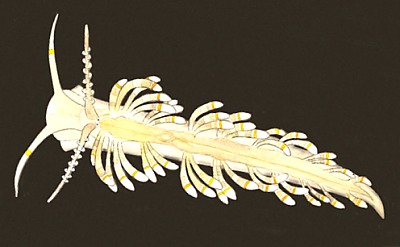
Dear Dr. Rudman,
I would like to record this Cuthona pinnifera which was collected from under a stone. We use to observe this species frequently but recently it has been rare. I saw the page on the Forum for Cuthona cf. pinnifera so I have also included a scan of the original drawing that was used in Opisthobranchia of Toyama Bay and adjacent waters.
Collection data: 20 April 2002. Uozu, Toyama Bay. Alive 12mm length. Water temp: 12.3deg C.
Photo - courtesy of the Takaoka Biological Club, Japan.
• Abe, T. (1964) Opisthobranchia of Toyama Bay and adjacent waters. Hokuryu-kan, Tokyo. 99pp., 36 Plates.
Sincerely yours
Shigeru Hayashi
jr9dsx@tko.fitweb.or.jp


Dear Shigeru,
Thanks for this information. It certainly clarifies the identity of this species.
Best wishes,
Bill Rudman
